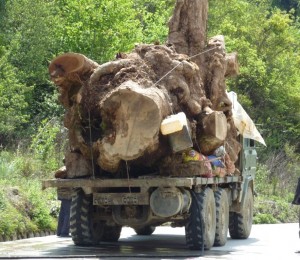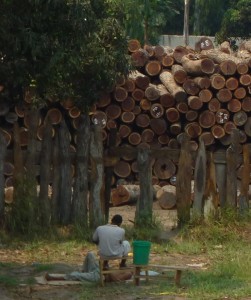China needs new laws to tackle illegal logging
The Chinese have a saying about drinking poison to quench a thirst, “yin zhen zhi ke”, used to warn against hasty remedies with consequences worse than the problem itself. A recently proposed method of tackling illegal logging is just such a case – it will in fact exacerbate the issue.
China is one of the world’s largest importers of timber products. So whether or not China takes measures to ensure those products are obtained legally, and what those measures will be, affects the survival of the world’s forests and ecologies as well as China’s international reputation.
Field studies over the past 10 years by the Environmental Investigation Agency in Indonesia, Myanmar, Russia, Laos, Vietnam, Mozambique, Madagascar and China itself have found China’s demand for timber is driving illegal logging, and that has a damning global consequence: the vital forest ecosystems have been irreparably damaged; incomes in communities relying on those forests have plummeted; and corruption and conflict are on the increase.

Log truck in Myanmar/Burma (c) EIA
The Chinese Government is taking the problem seriously but the key challenge is that the country has no relevant law, which means the bulk of illegally sourced timber often can enter China legally. As EIA reports reveal, billions of dollars’ worth of illegal timber flows into China every year.
Although Chinese law enforcement agencies have committed huge material and human resources to fighting timber smuggling, its customs authorities rely mainly on CITES, the UN Convention on International Trade in Endangered Species. But that convention bans trade in a limited number of tree species, therefore only a tiny fraction of illegal timber is stopped at the border.
The bulk of timber felled worldwide ends up in China, the US or the EU. But in the US and the EU, importers are required to exclude illegal timber. Firms that do not comply may find themselves in court.
This means that illegal timber is more likely to be sent to China, which lacks such a ‘firewall’. And over the years, EIA has found that illegal logging and smuggling by Chinese timber firms overseas often involves assistance or direct participation by local companies and officials.
Now the Chinese Government is promoting a voluntary code of conduct, the Guidelines for Overseas Sustainable Forest Products Trade and Investment by Chinese Enterprises. Despite its good intention to tackle the illegal timber trade, the Guidelines fail to deal with the root of the problem and will, like drinking poison when thirsty, only exacerbate the problem.
Why will the Guidelines fail? First, they do not deal with the core problem. The Guidelines attempt to control the behaviour of Chinese firms operating overseas. But the most pressing issue is deciding how to prevent illegal timber from entering China – and this is outside the scope of the Guidelines.

Log yard in Mozambique (c) EIA
Secondly, the Guidelines are voluntary, in effect little more than a set of slogans. Unlike laws or regulations, these will not constrain the behaviour of profit-motivated businesspeople and are of no use in law enforcement or punishment.
In the past, two similar sets of guidelines have been promulgated and done virtually nothing to stem the flow of illegal timber into China. Only a month after a training session on an earlier set of guidelines was held for Chinese firms in Pemba, Mozambique, one of those firms was found to be illegally exporting logs. This was a breach of the country’s ban on export of certain tree species in log form. Most of those logs would have been able to enter China legally.
Chinese forestry officials have privately admitted that the country will eventually need an enforceable law to halt illegal timber imports but said China’s current circumstances do not allow it and that the cost of legislation would be too high. EIA has heard all this before – policy-makers in the EU and the US once had the same concerns.
But times have changed. Global timber markets are becoming more regulated, with illegal timber being excluded from supply chains. Some Chinese firms are participating in this process but unless China bans the illegal timber trade those responsible firms will struggle to compete with their less honest counterparts and will in effect be punished.
EIA calls for the Chinese authorities not to allow another set of unenforceable voluntary guidelines to further delay the inevitable. Rather, put forward a timetable for creating an enforceable method of regulating China’s timber trade.
Further reading:
• First Class Crisis: China’s Criminal and Unsustainable Intervention in Mozambique’s Miombo Forests
• Myanmar’s Rosewood Crisis: Why key species and forests must be protected through CITES
• Routes of Extinction: The corruption and violence destroying Siamese rosewood in the Mekong
• Appetite for Destruction: China’s trade in illegal timber
.
.
打击非法木材,中国需要一部法律.
.
饮鸩止渴,在中国是一句家喻户晓的成语,意为饮用一种用鸟的羽毛浸制的毒药来解渴,指的用错误的办法来解决眼前的困难而不顾严重后果。毫不夸张地说,目前中国为解决非法木材贸易问题而提出的方案,正是这样一杯“能温柔地杀死你”的毒药。
当下,中国是全球最大的林产品进口国之一,因而中国是否、以及如何采取有效的措施,将非法木材阻挡在国外之外,关乎到全球森林和生态系统的存亡、更关乎中国的国际名誉。
过去十年,环境调查署(EIA)在印度尼西亚、缅甸、俄罗斯、老挝、越南、莫桑比克、马达加斯加以及中国的实地调查显示(多年调查报告链接在文后),为满足中国市场而进行的非法砍伐已经在全球产生了影响:森林生态系统遭到了不可撤销的破坏,依赖森林的社区遭受了巨大的收入损失,腐败和冲突也与日俱增。

Log truck in Myanmar/Burma (c) EIA
非法木材贸易问题已经引起了中国政府的重视,但问题是,中国目前并没有相关的立法,绝大部分在海外非法砍伐的木材,却能合法进入中国,EIA 的报告 揭示,每年进入中国的非法木材价值高达数十亿美元。
尽管中国的执法机关倾注了巨大人力物资来打击木材走私,中国海关目前主要依据CITES这一联合国公约执法,该公约所限制的树种有限,执法所获仅是沧海一粟。
全球每天被采伐的木材,大部分最终都到了中国、美国和欧盟三地。但在美国和欧盟,其法规要求进口商将非法木材排除在其供应链之外,未能进行尽职调查的企业可能遭到起诉。
由此,没有设立相应“防火墙”的中国,更将受到非法木材贸易的侵袭——EIA多年的调查发现,活跃在海外的众多中国不法木材企业的非法砍伐和木材走私活动,往往是得到了木材原产国当地企业和官员的助长和直接参与。
在此背景下,推行一份自愿性质的《中国企业境外可持续林产品贸易与投资指南》(后称《指南》)——目前中国有关部门为应对非法木材贸易而准备的方案,不仅治标不治本,而是如文章开头所说,可畏饮鸩止渴。
为什么《指南》这条路行不通?首先《指南》试图解决的,并非是问题的核心。《指南》的目的,是要约束中国木材企业在境外的行为。然而,中国目前的当务之急,是如何将被非法砍伐和走私出境的木材,阻挡在国门之外,这完全不属于《指南》的范畴。

Log yard in Mozambique (c) EIA
其次,《指南》的条款属于自愿的性质,实际上无异于“口号”。与法律法规不同,《指南》不可能对唯利是图的商人有实质性的约束,更不能用于执法和惩罚。
历史经验表明,在此之前发布的另外两份类似的《指南》,在阻止非法木材进入中国方面几乎毫无成效。例如仅在一场遵守前《指南》培训会一个月后,与会的中国企业就又违背了莫桑比克的原木禁令,而这些原木多数能合法进入中国。
在私下的沟通中,中国林业部门的官员坦言,长期来看,中国的确需要有一部可执行的法规,以阻挡非法木材入境,但目前中国的情况尚不允许,况且立法的成本太高。这套言辞在EIA听来非常熟悉,当时还没有进行立法的欧盟和美国的政策制定者们,也曾发表过类似的疑虑。
但是,时代不同了,全球木材市场正在日趋采取法律监管措施,将非法木材排除在供应链之外。实际上,已经有中国企业在努力从自己的供应链上排除非法木材。若再不设立法律禁令,这些负责任的中国企业将会越来越难以同经营非法木材的企业展开竞争,自律者将变相受到惩罚。
EIA向中国有关部门正式发出呼吁,不能再让一份无法进行执法的自愿《指南》推迟并本不可避免的举措——从今天起,阐明一个时间框架,为中国建立一套可以执行的木材监管办法。
Vicky Lee
Trade and Policy Analyst
• 《头等危机:中国对莫桑比克森林不可持续的干预》https://eia-international.org/first-class-crisis-chinas-criminal-and-unsustainable-intervention-in-mozambiques-miombo-forests
• 《缅甸红木危机:为何主要树种应该都受到CITES保护》https://eia-international.org/wp-content/uploads/Myanmars-rosewood-crisis-FINAL.pdf
• 《灭绝之路:正在毁灭湄公河大红酸枝的腐败和暴力》https://eia-international.org/wp-content/uploads/Routes-of-Extinction-Chinese-FINAL.pdf
• 《毁灭的欲望:中国的非法木材贸易》https://eia-international.org/wp-content/uploads/Appetite-for-Destruction-Final-Chinese.pdf
